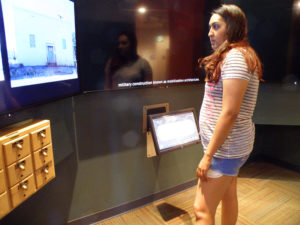
Photo Courtesy Bradbury Science Museum
Highlands media arts student Patricia Chavez troubleshoots the Behind the Fence interactive element of the exhibit, Manhattan on the Mesa: Manhattan Project Properties at Los Alamos, that opens July 14 at the Bradbury Science Museum.
Las Vegas, N.M – Visitors to the Bradbury Science Museum will experience the history of the Manhattan Project in a visually compelling way, thanks to new multimedia exhibits created by New Mexico Highlands University students.
The interactive exhibit, Manhattan on the Mesa: Manhattan Project Properties at Los Alamos, opens July 14 at the museum at 1350 Central Ave. in Los Alamos from 4 – 6 p.m. It tells the story of the Los Alamos National Laboratory scientists and others who worked at the top-secret New Mexico site to develop an atomic bomb during World War II.
“An outstanding benefit of working with the media arts students is their interest and mastery of cutting-edge techniques that visitors of the same age have come to expect,” said Linda Deck, director of LANL’s Bradbury Science Museum. “They used technology and other tools to interpret cultural sites for visitors such as 3-D models, videos, virtual reality, and graphic panels.”
In 2015, Congress, established the Manhattan Project National Historic Park of the National Park Service. The new Bradbury Science Museum exhibit explores LANL properties that are part of the park that are not open to the public yet.
“We want park visitors to come to the museum to see this new exhibit that tells the story of these Manhattan Project sites. We love working with the Highlands media arts students because they always deliver with their projects for the museum. They bring fresh ideas, expertise, energy and enthusiasm to projects, helped by dedication and nurturing from media arts faculty and mentors,” Deck said.
Twelve students in Highlands’ one-of-a-kind Program for Interactive Cultural Technology, or PICT, created the Manhattan Project exhibit. Media arts professors Miriam Langer and Kerry Loewen co-taught the class spring semester 2017.
“The PICT students worked very hard to understand the complex history of the Manhattan Project by researching historical documents, images and films, as well as making several trips ‘behind the fence’ to film the buildings that aren’t accessible yet to the public,” Langer said. “They developed the exhibits with diverse visitors in mind, making sure to address accessibility, create a multisensory experience, and consider the engagement of all ages.”
The exhibit elements the media arts students created in collaboration with the Bradbury Science Museum include:
Behind the Fence – The immersive team developed an interactive multisensory experience for the viewer using 360-degree cameras, three film screens, and touch-screen technology to give a virtual reality feeling of being inside the buildings.
Text and Graphics –The design team developed large-scale exhibit panels as big as 12’ by 8’ that display text and graphic information about the buildings, a timeline, and historic photos.
Racing Toward Dawn – The video team created a 15-minute video depicting Los Alamos National Laboratory’s role in the Manhattan Project by producing a timeline using historic photographs and video footage and writing a script for narration.
They Changed the World – The interactive team created a large touch-screen interactive installation highlighting the people and scientists who lived and worked on the Manhattan Project, based upon aj Melnick’s book, They Changed the World.
Secret Passes – The interactive team also created a scavenger hunt that leads people through the exhibit using technology to decode images using colored filters, and radio frequency ID tags to track users’ progress.
“It was rewarding to see our class come together using all the media platforms to create an exhibit that gives visitors a thorough look into the importance of the Los Alamos sites that were classified and restricted,” said Patricia Chavez, a media arts AmeriCorps intern who was one of the project managers. “It was exciting to create an exhibit for a new national park, knowing that visitors from around the world would experience it.”
Chavez, a Las Vegas, New Mexico native, earned her BFA in media arts in May 2017. She begins her MFA studies in film production at USC in August.
Dre’ Gallegos was another project manager. The Las Vegas native earned both her BFA and MA in media arts from Highlands and begins a position at Meow Wolf museum in Santa Fe in July.
Led by Robert Oppenheimer, scientists began working at the Los Alamos site in 1942 to design and fabricate the first atomic bomb. The Manhattan Project Los Alamos location atop remote Pajarito Plateau was an unprecedented effort where prominent scientists, engineers, technicians and support personnel collaborated to design and fabricate the first nuclear weapons, according to the National Park Service.
The U.S. dropped the first atomic bomb Aug. 6, 1945, on Hiroshima, Japan, with a second bomb dropped on Nagasaki, Japan Aug. 9. Japan surrendered Aug. 14, 1945.
